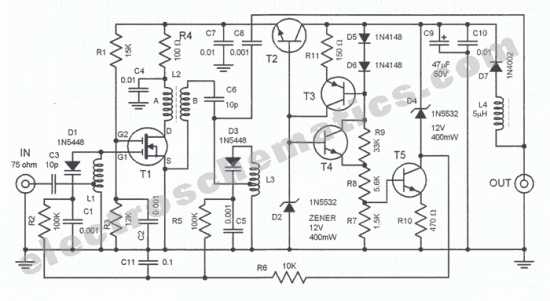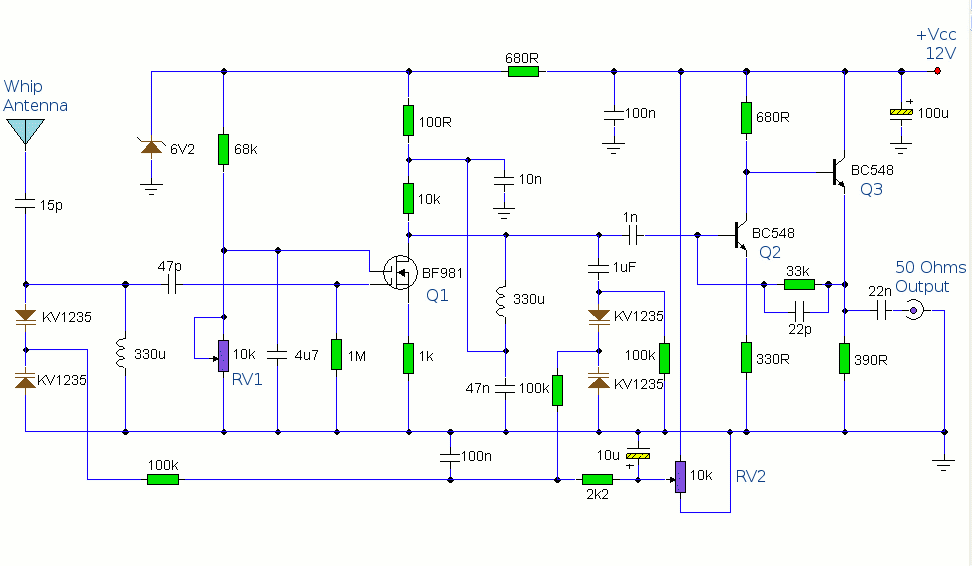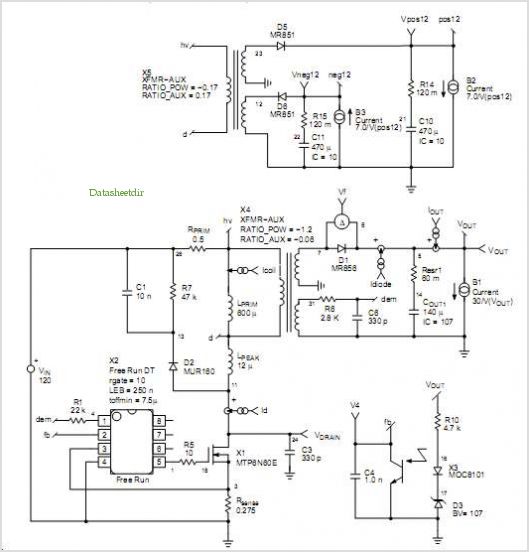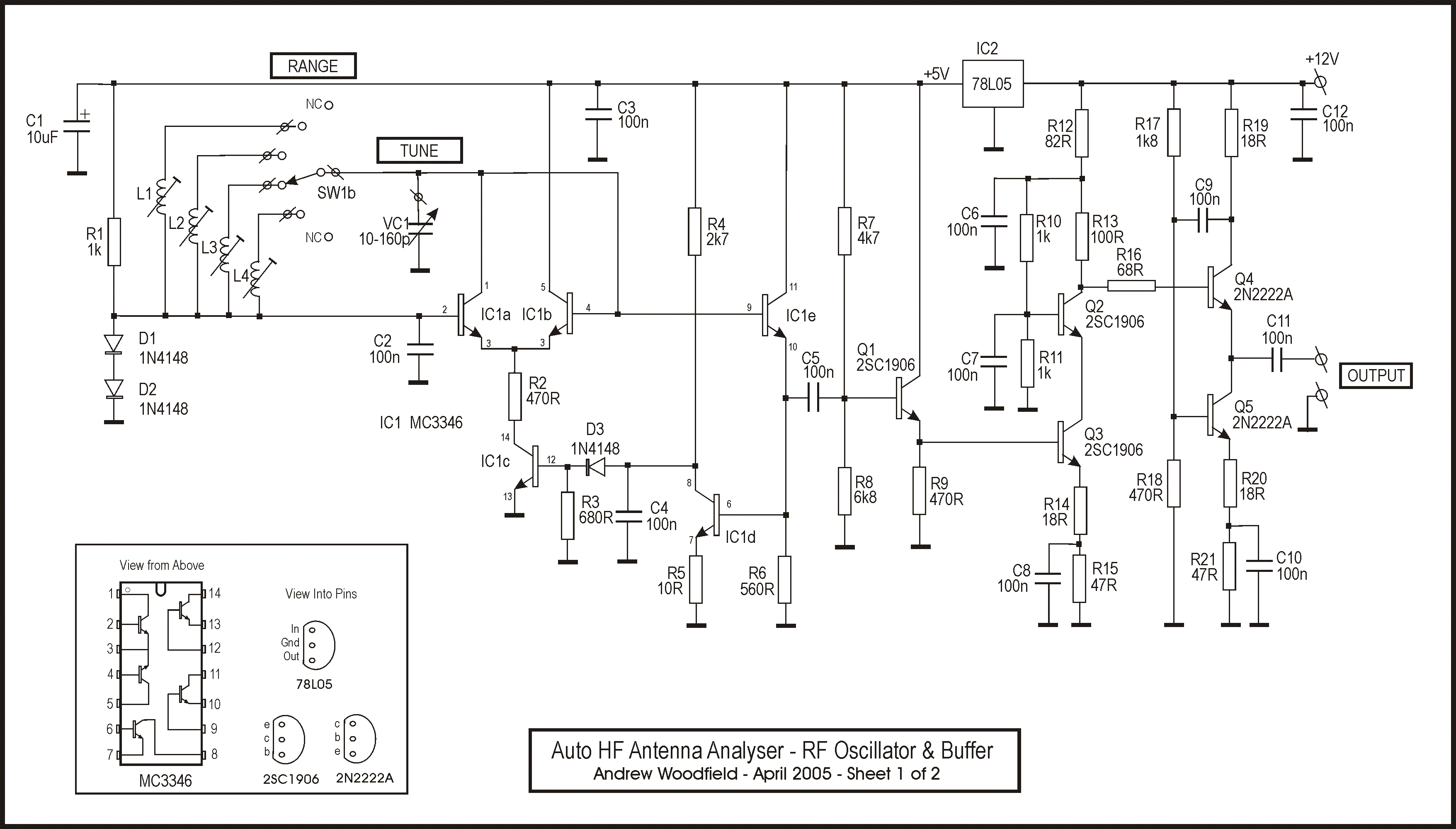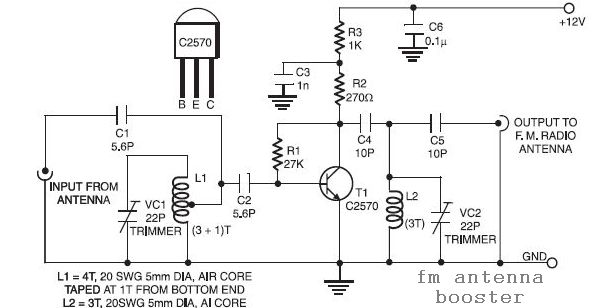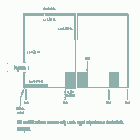
A Compact Co-Planar Waveguide-Fed Zeroth-Order Resonant Antenna
The zeroth-order resonant (ZOR) antenna, constructed using microstrip transmission lines, has gained significant attention in small antenna applications. Various techniques have been utilized to miniaturize the composite right/left-handed (CRLH) transmission line (TL) unit cell size, such as employing meander line shunt stubs or the Sievenpipe's mushroom structure. A mushroom-type two unit-cell ZOR antenna measuring 0.17λ × 0.17λ at 3.38 GHz was demonstrated, achieving a peak gain of 0.87 dBi and a radiation efficiency of 70%. To further minimize the antenna size, a spiral slot structure on the ground was implemented, resulting in a peak gain of 0.28 dBi and a radiation efficiency of 62%. However, smaller ZOR antennas utilizing a CRLH resonator with two or three cells often exhibit low radiation efficiency and poor gain in the zeroth-order resonant mode. Various approaches have been explored to enhance the efficiency of ZOR antennas. One such method involves increasing the vertical via-hole height above the enhanced ground plane using an air substrate, though this presents manufacturing challenges. A recent co-planar waveguide (CPW) type ZOR antenna measuring 0.145λ × 0.172λ at 2.03 GHz was reported, but it only achieved a peak gain of 1.35 dBi and a radiation efficiency of 62%, attributed to the small radiator size and losses from the antenna structures. To realize an efficient ZOR antenna with higher gain, increasing the number of CRLH resonator unit cells is suggested. However, while the gain improves with more unit cells, the antenna size also increases. This work presents a compact two unit-cell ZOR antenna with enhanced gain and radiation efficiency. To achieve a smaller size and improved efficiency, two symmetrical straight metal-strip lines bent at 90 degrees are employed as shunt inductors instead of meander lines. The characteristics and efficiency enhancements of the proposed ZOR antenna have been validated using CST MWS (Microwave Studio), a commercial 3D field simulation tool. The configuration consists of two metallic layers separated by a dielectric substrate, with each layer incorporating a common ground plane, patch elements, and shunt stubs. The CRLH TL configuration derives its series capacitance (CL) from metal-insulator-metal (MIM) parallel-plate capacitors, while shunt inductances (LL) utilize shunt stubs shorted to the CPW ground plane via holes. The parasitic series inductance (LR) is provided by the MIM capacitors, and the parasitic shunt capacitor (CR) arises from the capacitance between the shunt stub line and the ground plane. The unit cells exhibit a symmetric configuration with a CPW-fed structure and are designed on an FR-4 substrate (relative permittivity = 4.4, height = 0.8 mm) using microstrip technology. The values of capacitances (CL, CR) and inductances (LL, LR) can be determined as outlined in the literature, yielding CL = 1.5 pF, LL = 4.5 nH, CR = 0.5 pF, and LR = 1.4 nH at f0 = 3.1 GHz. The ZOR antenna can operate in either the CRLH series mode (by short-circuiting) or the CRLH shunt mode (by open-circuiting). The presented antenna is balanced and excited open-ended, confining energy within the shunt elements. By applying periodic boundary conditions, the dispersion relation of the CRLH TL unit cell is established, with a dispersion diagram plotted to demonstrate balanced resonance and a transition frequency at f0 = 3.1 GHz. The uniform CRLH TL structure can be transformed into a resonator when open-ended or short-ended. The resonance of a CRLH resonator with N unit cells occurs at an infinite wavelength, leading to a flat field distribution. This study introduces a shunt mode ZOR antenna utilizing series MIM capacitors and straight strip shunt inductors. To decrease the resonant frequency, a meander line forming shunt inductor was traditionally used in compact ZOR antennas, but this configuration can lead to reduced radiation efficiency due to opposing horizontal current elements. Therefore, increasing the length of the straight strip while bending it at 90 degrees over the CPW ground plane is expected to enhance radiation efficiency. To extend the shunt stub length further, a via-hole was added to connect the end of the shunt stub to the ground plane, increasing the shunt inductance (LL) and thereby reducing the resonant frequency of the antenna. The proposed ZOR antenna comprises two element cells and a CPW feeder line, with a total electrical size of 0.22λ × 0.22λ at 3.1 GHz, resulting in a unit cell length of approximately 4.5 mm. To cascade two MIM capacitors in series, the lower conductor plate of the first capacitor and the upper conductor plate of the second capacitor are connected via two holes. The equivalent circuit model for the proposed shunt mode ZOR antenna is presented, detailing the gap capacitance (Cg) and shunt conductance (G). The design parameters extracted include CL = 1.5 pF, LL = 4.5 nH, CR = 0.5 pF, LR = 1.4 nH, and G = 0.0012 S. Additionally, the gap length between the CPW feeder line and the unit cell is adjusted to achieve optimal impedance matching to a 50Ω coaxial probe. The dependency of input impedance on the gap distance is examined, revealing that as the gap distance increases, the magnitudes of the real and imaginary parts decrease, with a notable increase in resonant frequency. When the gap distance is set to 0.4 mm, the input resistance approaches 50Ω, while the input reactance is approximately 0Ω at the ZOR frequency of 3.05 GHz, confirming good impedance matching. Simulated input impedance loci illustrate this behavior, with the ZOR frequency shifting from 3.1 GHz to 3.05 GHz due to the capacitance of the gap and capacitive slot. Simulated electric field and current distributions at the ZOR frequency of 3.05 GHz indicate that the electric field is uniformly distributed across the MIM capacitors, with significant surface current flowing along the shunt strip inductor and via. The distribution of surface currents on the bottom metal plane layer is analyzed, showing decomposition into horizontal and vertical components, both contributing to the maximum gain radiation pattern along the x-axis. The proposed ZOR antenna, featuring two symmetrical shunt inductors bent at 90 degrees, demonstrates enhanced efficiency and gain. The prototype ZOR antenna was fabricated on an FR-4 substrate with a relative dielectric constant of 4.4, a thickness of 0.8 mm, and a loss tangent of 0.025. The simulated and measured return loss (|S11|) indicates good matching from 2.7 to 3.25 GHz, yielding a measured return loss bandwidth of 55 MHz. The antenna exhibits three resonance modes (n = 0, and n = ±1) through the cascading of two CRLH unit cells, with a measured ZOR frequency of 2.97 GHz. Simulated and measured E-plane and H-plane radiation patterns at this frequency reveal horizontal linear electric field polarization, akin to a short dipole antenna along the y-axis, with the maximum radiation direction aligned along the x-axis. The measured peak gain of the antenna is 3.07 dBi, resulting in a radiation efficiency of 75%. A compact ZOR antenna with improved gain and radiation efficiency has been developed based on the zeroth-order resonance principle. The use of two symmetrical straight metal-strip lines bent at 90 degrees as shunt inductors, along with a gap capacitor for impedance matching, facilitates the compact size and enhanced radiation efficiency of the CPW-fed ZOR antenna. The fabricated prototype demonstrates excellent performance with a maximum gain of 3.07 dBi and a radiation efficiency of 75% at 2.97 GHz.Zeroth-order resonant (ZOR) antenna manufactured on microstrip transmission lines has attracted great interest in the small antenna applications. Many techniques have been employed in order to miniaturize the composite right/left handed (CRLH) transmission line (TL) unit cell size, such as using meander line shunt stubs [1] or using the Sievenpipe
r`s mushroom structure[2]. In[2], a mushroom-type two unit-cells ZORA with the small size of 0. 17 »0 0. 17 »0 at 3. 38 GHz was presented. The peak gain and radiation efficiency of this antenna were 0. 87 dBi and 70%, respectively. In order to further reduce the antenna size, a spiral slot structure on the ground was used[3]; the measured peak gain and radiation efficiency of this antenna were 0. 28 dBi and 62%, respectively. However, small ZOR antennas employing a CRLH resonator made up of two or three cells suffer from a low radiation efficiency and poor gain in the zeroth-order resonant mode[4].
Various solutions designed to improve the ZOR an- tenna`s efficiency have been under investigation. One approach used for ZOR antenna radiation efficiency has been to increase the vertical via-hole height over the improvement ground plane using an air substrate[5]. The drawbackof this design is in the difficulties found in manufacturing the antenna. Recently, a 0. 145 »0 0. 172 »0 at 2. 03 GHz co-planar waveguide (CPW) type ZOR antenna was presented in[6]. However, its measured peak gain and radiation efficiency were only 1. 35 dBi and 62%, respectively. This is thought to be due to the small radiator size, as well as from losses caused by the antenna structures, such as the shorted meander lines.
In order to achieve an efficient ZOR antenna with a high gain, it is thought that the number of CRLH resonator unit cells needs to be increased[7]. Although the gain of the ZOR antenna becomes higher as the number of unit cells increases, the size of the antenna also becomes larger.
In this work, a compact two unit-cell ZOR antenna with an improved gain and radiation efficiency is presented. In order to reduce the antenna size and to improve its efficiency, two symmetrical straight metal-strip lines, bent by 900, are used for the shunt inductors instead of meander lines.
The proposed ZOR antenna characteristics and efficiency enhancement have been verified using CST MWS (Micro Wave Studio), a commercial 3D field simulation tool. A perspective view of the unit cell structure of the pro-posed CRLH TL and its equivalent circuit model are shown in Figure 1.
The new configuration consists of two metallic layers isolated by a dielectric substrate; and each layer is made with a common ground plane, patch elements, and shunt stubs. The proposed CRLH TL configuration obtains its series capacitance (CL) by using metal-insulator-metal (MIM) parallel-plate capacitors; the shunt inductances (LL) use shunt stubs shorted by via-holes to the CPW ground plane.
The parasitic series inductance (LR) is provided by the MIM capacitors and the parasitic shunt capacitor (CR) is provided by the capacitance between the shunt stub line and the ground plane. The unit cells have a symmetric configuration with a CPW-fed structure. The unit cell have been designed on a FR-4 substrate (relative permittivity = 4. 4, height = 0. 8 mm) using microstrip technology. The values of capacitances (CL, CR) and inductances (LL, LR) can be calculated according to [8] as are the microstrip line width, line thickness, substrate thickness, length of the line section and area of capacitor.
The determined values from the equivalent elements results in CL = 1. 5 pF, LL = 4. 5 nH, CR = 0. 5 pF, and LR = 1. 4 nH at f0 = 3. 1 GHz. A ZOR antenna can be operated either in the CRLH series mode (by short-circuiting) or in the CRLH shunt mode (by open-circuiting). The antenna presented in this paper is balanced and excited open-ending, so that its energy will be confined in the shunt elements.
By applying periodic boundary conditions, the CRLH TL unit cell`s dispersion relation is determined to be ), the dispersion diagram of the CRLH TL unit cell is plotted in Figure 2. As shown in Figure 2, the proposed CRLH TL exhibits balanced resonance and the transition frequency yielding f0 = 3.
1 GHz. The uniform CRLH TL structure can be transformed into a resonator when it is open-ended or short-ended. A CRLH resonator with N unit cells is used, its resonance occurs when corresponds to an infinite wavelength and there to a flat field distribution.
This study presents a shunt mode ZOR antenna using series MIM capacitors and straight strip shunt inductors. As a result, the zeroth-order resonance mode frequency In order to decrease this resonant frequency a meander line forming shunt inductor was used in the conventional compact ZOR antenna.
In this case, the contribution from the horizontal current elements flowing in the opposed direction is eliminated at the far field. Consequently, the radiation efficiency of the ZOR antenna decreases. So the increase in the straight strip length together with bending the straight strip by 900 over the CPW ground plane should enhance the radiation efficiency.
In order to further increase the shunt stub length, a via-hole was connected from the end of the shunt stub to the ground plane. The resultant increasing in the shunt inductance (LL) reduces the resonant frequency of the antenna. As shown in Figure 3(a)-(c), the proposed ZOR antenna consists of two element cells and a CPW feeder-line.
The total electrical size of the proposed ZOR antenna is 0. 22 »0 22 mm) at 3. 1 GHz; the length of a unit cell is therefore p = 4. 5 mm (‰ »g /4). In order to cascade two MIM capacitors in series, the lower conductor plate of the first capacitor and the upper conductor plate of the second capacitor were connected by two via-holes. The equivalent circuit model for the proposed shunt mode ZOR antenna is shown in Figure 3(d), where Cg and G are gap capacitance and shunt conductance, respectively.
The extracted design parameters are as follows: CL = 1. 5 pF, LL = 4. 5 nH, CR = 0. 5 pF, LR = 1. 4 nH, and G = 0. 0012 S. In addition, the gap length between the CPW feeder-line and the unit cell was adjusted in order to achieve good impedance matching for the proposed ZOR antenna to a 50 © coaxial probe. The dependency of the input impedance on the gap distance between the CPW feeder-line and the unit cell was investigated and the impedance responses with real and imaginary part are presented in Figure 4.
As shown in Figure 4, the magnitudes of real and imaginary parts decreased as the gap distance g increases, and the resonant frequency increase markedly. When the gap distance g = 0. 4 mm, the input resistance R ‰ 50 ©, while the of the input reactance x ‰ 0 © at the ZOR frequency of 3.
05 GHz. Therefore, the antenna was matched to a 50 © coaxial probe. The simulated input impedance loci of the proposed antenna are shown in Figure 5. In this case, the ZOR frequency changed from 3. 1 GHz to 3. 05 GHz due to the capacitance of the gap and capacitive slot. The simulated normal electric field distributions and current distributions along the metallic surfaces obtain from CST`s MWS at the simulated ZOR frequency f0 = 3. 05 GHz are shown in Figure 6. It can be seen that the electric field on the MIM capacitors near uniformly distributed with equal magnitude and phase, and most of the surface current flows on the shunt strip inductor and via.
The magnitude of the surface current distribution on the bottom metal plane layer of the antenna is shown in Figure 7. These currents on the shunt strip inductor are decomposed into two parts, named IH (horizontal component) and IV (vertical component).
The horizontal component currents along the two shunt strip inductors are equal in magnitude and opposite in phase. As a result, the maximum gain radiation pattern is generated along the parallel to the shunt strip inductors (x-axis).
The vertical component currents along the two shunt strip inductors are equal in magnitude and phase. As a result, the maximum gain radiation pattern is also generated along the parallel to the shunt strip inductors (x-axis).
These results show that the proposed ZOR antenna with two symmetrical shunts inductors, bent by 900, exhibits an improved efficiency and gain. The photograph of the prototype ZOR antenna is shown in Figure 8. It was fabricated on a FR-4 substrate with the relative dielectric constant 4. 4, a thickness of 0. 8 mm and a loss tan = 0. 025. The simulated and measured return loss |S11| of the fabricated ZOR antenna are shown in Figure 8. We can see that the ZOR antenna was well matched from 2. 7 to 3. 25 GHz, which results in a measured return loss bandwidth (-10 dB) of 55 MHz. As can be seen in Figure 9, the ZOR antenna exhibits three resonance modes (n = 0, and n = ±1) by cascading two CRLH unit cells.
The measured ZOR (n = 0) frequency was observed to be f0 = 2. 97 GHz. The simulated and measured E-plane and H-plane radiation patterns at the ZOR frequency of 2. 97 GHz are shown in Figure 10. The proposed ZOR antenna exhibits radiation patterns with a horizontal linear electric field polarization similar to that of a short dipole antenna along the y-axis. Since the symmetric unit cells were used, the maximum radiation direction of the antenna was along x-axis.
The measured peak gain using the comparison method is 3. 07 dBi, which resulted in a measured radiation efficiency of 75%. A compact ZOR antenna with an improved gain and radiation efficiency has been presented based on the zeroth-order resonance principle. In order to realize the compact size and enhance the radiation efficiency, two symmetrical straight metal-strip lines, bent by 90 degree, were used as a shunt inductor instead of a meander line.
For the efficient operation of the proposed CPW-fed ZOR antenna a gap capacitor was used for good impedance matching to the desired ZOR frequency. As a result, the ZOR antenna was well matched from 2. 7 to 3. 25 GHz. The fabricated prototype ZOR antenna exhibits a horizontal linear electric field polarization with an excellent maximum gain and efficiency of 3.
07 dBi and 75%, respectively, at 2. 97 GHz. This research was supported by the Basic Science Research Program through the National Research Foundation of Korea (NRF) and funded by the Ministry of Education, Science and Technology (No. 2010-0011646). A. Sanada, M. kimura, I. Awai, C. Caloz, and T. Itoh, A planar zeroth order resonator antenna using a left-handed transmission line, in Proc. 34th Eur. Microw. Conf. , Ams-terdam, Netherlands, pp. 1341 1344, Oct. 2004. A. Lai, K. M. K. H. Leong, and T. Itoh, Infinite wavelength resonant antennas with monopolar radiation pattern based on periodic structures, IEEE Trans.
Antennas and Propag. , vol. 55, pp. 868-876, Mar. 2007. C. J. Lee, K. M. K. H. Leong, and T. Itoh, Compact dual-band antenna using an anisotropic metamaterial, in Proc. 36th Eur. Microw. Conf. , Manchester, U. K. , pp. 1044-1047, Sept. 2006. T. Jang, J. Choi, and S. Lim, Compact coplanar waveguide (CPW)-fed zeroth-order resonant antennas with extended bandwidth and high efficiency on vialess single layer , IEEE Trans. Antennas and Propag. , vol. 59, pp. 363-372, Feb. 2011. A. Rennings, T. Liebig, C. Caloz, and P. Waldow, MIM CRLH series mode zeroth order resonant antenna (ZORA) imple-mented in LTCC technology, in Proc.
Asia-Pacific Microw. Conf. , Bangkok, pp. 1-4, Dec. 2007. 🔗 External reference
r`s mushroom structure[2]. In[2], a mushroom-type two unit-cells ZORA with the small size of 0. 17 »0 0. 17 »0 at 3. 38 GHz was presented. The peak gain and radiation efficiency of this antenna were 0. 87 dBi and 70%, respectively. In order to further reduce the antenna size, a spiral slot structure on the ground was used[3]; the measured peak gain and radiation efficiency of this antenna were 0. 28 dBi and 62%, respectively. However, small ZOR antennas employing a CRLH resonator made up of two or three cells suffer from a low radiation efficiency and poor gain in the zeroth-order resonant mode[4].
Various solutions designed to improve the ZOR an- tenna`s efficiency have been under investigation. One approach used for ZOR antenna radiation efficiency has been to increase the vertical via-hole height over the improvement ground plane using an air substrate[5]. The drawbackof this design is in the difficulties found in manufacturing the antenna. Recently, a 0. 145 »0 0. 172 »0 at 2. 03 GHz co-planar waveguide (CPW) type ZOR antenna was presented in[6]. However, its measured peak gain and radiation efficiency were only 1. 35 dBi and 62%, respectively. This is thought to be due to the small radiator size, as well as from losses caused by the antenna structures, such as the shorted meander lines.
In order to achieve an efficient ZOR antenna with a high gain, it is thought that the number of CRLH resonator unit cells needs to be increased[7]. Although the gain of the ZOR antenna becomes higher as the number of unit cells increases, the size of the antenna also becomes larger.
In this work, a compact two unit-cell ZOR antenna with an improved gain and radiation efficiency is presented. In order to reduce the antenna size and to improve its efficiency, two symmetrical straight metal-strip lines, bent by 900, are used for the shunt inductors instead of meander lines.
The proposed ZOR antenna characteristics and efficiency enhancement have been verified using CST MWS (Micro Wave Studio), a commercial 3D field simulation tool. A perspective view of the unit cell structure of the pro-posed CRLH TL and its equivalent circuit model are shown in Figure 1.
The new configuration consists of two metallic layers isolated by a dielectric substrate; and each layer is made with a common ground plane, patch elements, and shunt stubs. The proposed CRLH TL configuration obtains its series capacitance (CL) by using metal-insulator-metal (MIM) parallel-plate capacitors; the shunt inductances (LL) use shunt stubs shorted by via-holes to the CPW ground plane.
The parasitic series inductance (LR) is provided by the MIM capacitors and the parasitic shunt capacitor (CR) is provided by the capacitance between the shunt stub line and the ground plane. The unit cells have a symmetric configuration with a CPW-fed structure. The unit cell have been designed on a FR-4 substrate (relative permittivity = 4. 4, height = 0. 8 mm) using microstrip technology. The values of capacitances (CL, CR) and inductances (LL, LR) can be calculated according to [8] as are the microstrip line width, line thickness, substrate thickness, length of the line section and area of capacitor.
The determined values from the equivalent elements results in CL = 1. 5 pF, LL = 4. 5 nH, CR = 0. 5 pF, and LR = 1. 4 nH at f0 = 3. 1 GHz. A ZOR antenna can be operated either in the CRLH series mode (by short-circuiting) or in the CRLH shunt mode (by open-circuiting). The antenna presented in this paper is balanced and excited open-ending, so that its energy will be confined in the shunt elements.
By applying periodic boundary conditions, the CRLH TL unit cell`s dispersion relation is determined to be ), the dispersion diagram of the CRLH TL unit cell is plotted in Figure 2. As shown in Figure 2, the proposed CRLH TL exhibits balanced resonance and the transition frequency yielding f0 = 3.
1 GHz. The uniform CRLH TL structure can be transformed into a resonator when it is open-ended or short-ended. A CRLH resonator with N unit cells is used, its resonance occurs when corresponds to an infinite wavelength and there to a flat field distribution.
This study presents a shunt mode ZOR antenna using series MIM capacitors and straight strip shunt inductors. As a result, the zeroth-order resonance mode frequency In order to decrease this resonant frequency a meander line forming shunt inductor was used in the conventional compact ZOR antenna.
In this case, the contribution from the horizontal current elements flowing in the opposed direction is eliminated at the far field. Consequently, the radiation efficiency of the ZOR antenna decreases. So the increase in the straight strip length together with bending the straight strip by 900 over the CPW ground plane should enhance the radiation efficiency.
In order to further increase the shunt stub length, a via-hole was connected from the end of the shunt stub to the ground plane. The resultant increasing in the shunt inductance (LL) reduces the resonant frequency of the antenna. As shown in Figure 3(a)-(c), the proposed ZOR antenna consists of two element cells and a CPW feeder-line.
The total electrical size of the proposed ZOR antenna is 0. 22 »0 22 mm) at 3. 1 GHz; the length of a unit cell is therefore p = 4. 5 mm (‰ »g /4). In order to cascade two MIM capacitors in series, the lower conductor plate of the first capacitor and the upper conductor plate of the second capacitor were connected by two via-holes. The equivalent circuit model for the proposed shunt mode ZOR antenna is shown in Figure 3(d), where Cg and G are gap capacitance and shunt conductance, respectively.
The extracted design parameters are as follows: CL = 1. 5 pF, LL = 4. 5 nH, CR = 0. 5 pF, LR = 1. 4 nH, and G = 0. 0012 S. In addition, the gap length between the CPW feeder-line and the unit cell was adjusted in order to achieve good impedance matching for the proposed ZOR antenna to a 50 © coaxial probe. The dependency of the input impedance on the gap distance between the CPW feeder-line and the unit cell was investigated and the impedance responses with real and imaginary part are presented in Figure 4.
As shown in Figure 4, the magnitudes of real and imaginary parts decreased as the gap distance g increases, and the resonant frequency increase markedly. When the gap distance g = 0. 4 mm, the input resistance R ‰ 50 ©, while the of the input reactance x ‰ 0 © at the ZOR frequency of 3.
05 GHz. Therefore, the antenna was matched to a 50 © coaxial probe. The simulated input impedance loci of the proposed antenna are shown in Figure 5. In this case, the ZOR frequency changed from 3. 1 GHz to 3. 05 GHz due to the capacitance of the gap and capacitive slot. The simulated normal electric field distributions and current distributions along the metallic surfaces obtain from CST`s MWS at the simulated ZOR frequency f0 = 3. 05 GHz are shown in Figure 6. It can be seen that the electric field on the MIM capacitors near uniformly distributed with equal magnitude and phase, and most of the surface current flows on the shunt strip inductor and via.
The magnitude of the surface current distribution on the bottom metal plane layer of the antenna is shown in Figure 7. These currents on the shunt strip inductor are decomposed into two parts, named IH (horizontal component) and IV (vertical component).
The horizontal component currents along the two shunt strip inductors are equal in magnitude and opposite in phase. As a result, the maximum gain radiation pattern is generated along the parallel to the shunt strip inductors (x-axis).
The vertical component currents along the two shunt strip inductors are equal in magnitude and phase. As a result, the maximum gain radiation pattern is also generated along the parallel to the shunt strip inductors (x-axis).
These results show that the proposed ZOR antenna with two symmetrical shunts inductors, bent by 900, exhibits an improved efficiency and gain. The photograph of the prototype ZOR antenna is shown in Figure 8. It was fabricated on a FR-4 substrate with the relative dielectric constant 4. 4, a thickness of 0. 8 mm and a loss tan = 0. 025. The simulated and measured return loss |S11| of the fabricated ZOR antenna are shown in Figure 8. We can see that the ZOR antenna was well matched from 2. 7 to 3. 25 GHz, which results in a measured return loss bandwidth (-10 dB) of 55 MHz. As can be seen in Figure 9, the ZOR antenna exhibits three resonance modes (n = 0, and n = ±1) by cascading two CRLH unit cells.
The measured ZOR (n = 0) frequency was observed to be f0 = 2. 97 GHz. The simulated and measured E-plane and H-plane radiation patterns at the ZOR frequency of 2. 97 GHz are shown in Figure 10. The proposed ZOR antenna exhibits radiation patterns with a horizontal linear electric field polarization similar to that of a short dipole antenna along the y-axis. Since the symmetric unit cells were used, the maximum radiation direction of the antenna was along x-axis.
The measured peak gain using the comparison method is 3. 07 dBi, which resulted in a measured radiation efficiency of 75%. A compact ZOR antenna with an improved gain and radiation efficiency has been presented based on the zeroth-order resonance principle. In order to realize the compact size and enhance the radiation efficiency, two symmetrical straight metal-strip lines, bent by 90 degree, were used as a shunt inductor instead of a meander line.
For the efficient operation of the proposed CPW-fed ZOR antenna a gap capacitor was used for good impedance matching to the desired ZOR frequency. As a result, the ZOR antenna was well matched from 2. 7 to 3. 25 GHz. The fabricated prototype ZOR antenna exhibits a horizontal linear electric field polarization with an excellent maximum gain and efficiency of 3.
07 dBi and 75%, respectively, at 2. 97 GHz. This research was supported by the Basic Science Research Program through the National Research Foundation of Korea (NRF) and funded by the Ministry of Education, Science and Technology (No. 2010-0011646). A. Sanada, M. kimura, I. Awai, C. Caloz, and T. Itoh, A planar zeroth order resonator antenna using a left-handed transmission line, in Proc. 34th Eur. Microw. Conf. , Ams-terdam, Netherlands, pp. 1341 1344, Oct. 2004. A. Lai, K. M. K. H. Leong, and T. Itoh, Infinite wavelength resonant antennas with monopolar radiation pattern based on periodic structures, IEEE Trans.
Antennas and Propag. , vol. 55, pp. 868-876, Mar. 2007. C. J. Lee, K. M. K. H. Leong, and T. Itoh, Compact dual-band antenna using an anisotropic metamaterial, in Proc. 36th Eur. Microw. Conf. , Manchester, U. K. , pp. 1044-1047, Sept. 2006. T. Jang, J. Choi, and S. Lim, Compact coplanar waveguide (CPW)-fed zeroth-order resonant antennas with extended bandwidth and high efficiency on vialess single layer , IEEE Trans. Antennas and Propag. , vol. 59, pp. 363-372, Feb. 2011. A. Rennings, T. Liebig, C. Caloz, and P. Waldow, MIM CRLH series mode zeroth order resonant antenna (ZORA) imple-mented in LTCC technology, in Proc.
Asia-Pacific Microw. Conf. , Bangkok, pp. 1-4, Dec. 2007. 🔗 External reference
Warning: include(partials/cookie-banner.php): Failed to open stream: Permission denied in /var/www/html/nextgr/view-circuit.php on line 713
Warning: include(): Failed opening 'partials/cookie-banner.php' for inclusion (include_path='.:/usr/share/php') in /var/www/html/nextgr/view-circuit.php on line 713
